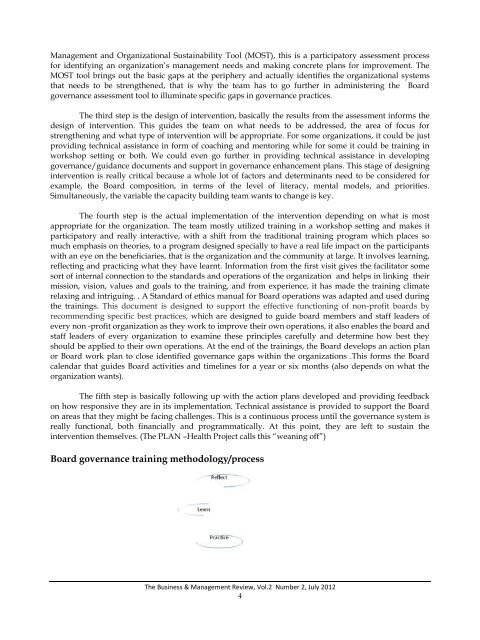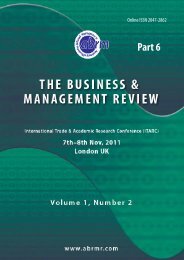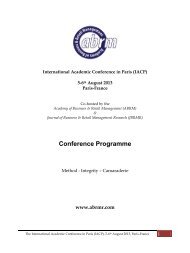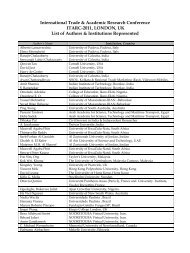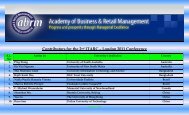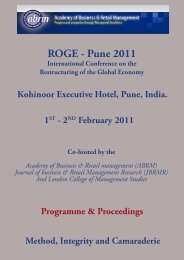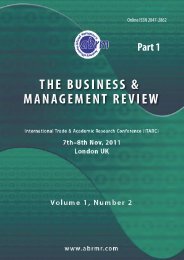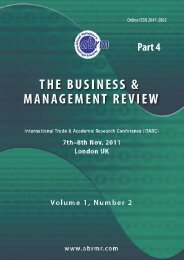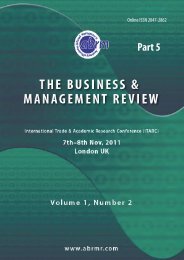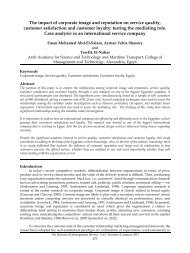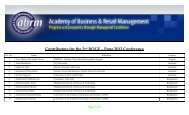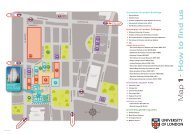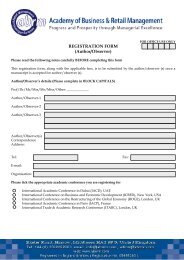THE BUSINESS & MANAGEMENT REVIEW - The Academy of ...
THE BUSINESS & MANAGEMENT REVIEW - The Academy of ...
THE BUSINESS & MANAGEMENT REVIEW - The Academy of ...
Create successful ePaper yourself
Turn your PDF publications into a flip-book with our unique Google optimized e-Paper software.
Management and Organizational Sustainability Tool (MOST), this is a participatory assessment process<br />
for identifying an organization’s management needs and making concrete plans for improvement. <strong>The</strong><br />
MOST tool brings out the basic gaps at the periphery and actually identifies the organizational systems<br />
that needs to be strengthened, that is why the team has to go further in administering the Board<br />
governance assessment tool to illuminate specific gaps in governance practices.<br />
<strong>The</strong> third step is the design <strong>of</strong> intervention, basically the results from the assessment informs the<br />
design <strong>of</strong> intervention. This guides the team on what needs to be addressed, the area <strong>of</strong> focus for<br />
strengthening and what type <strong>of</strong> intervention will be appropriate. For some organizations, it could be just<br />
providing technical assistance in form <strong>of</strong> coaching and mentoring while for some it could be training in<br />
workshop setting or both. We could even go further in providing technical assistance in developing<br />
governance/guidance documents and support in governance enhancement plans. This stage <strong>of</strong> designing<br />
intervention is really critical because a whole lot <strong>of</strong> factors and determinants need to be considered for<br />
example, the Board composition, in terms <strong>of</strong> the level <strong>of</strong> literacy, mental models, and priorities.<br />
Simultaneously, the variable the capacity building team wants to change is key.<br />
<strong>The</strong> fourth step is the actual implementation <strong>of</strong> the intervention depending on what is most<br />
appropriate for the organization. <strong>The</strong> team mostly utilized training in a workshop setting and makes it<br />
participatory and really interactive, with a shift from the traditional training program which places so<br />
much emphasis on theories, to a program designed specially to have a real life impact on the participants<br />
with an eye on the beneficiaries, that is the organization and the community at large. It involves learning,<br />
reflecting and practicing what they have learnt. Information from the first visit gives the facilitator some<br />
sort <strong>of</strong> internal connection to the standards and operations <strong>of</strong> the organization and helps in linking their<br />
mission, vision, values and goals to the training, and from experience, it has made the training climate<br />
relaxing and intriguing. . A Standard <strong>of</strong> ethics manual for Board operations was adapted and used during<br />
the trainings. This document is designed to support the effective functioning <strong>of</strong> non-pr<strong>of</strong>it boards by<br />
recommending specific best practices, which are designed to guide board members and staff leaders <strong>of</strong><br />
every non -pr<strong>of</strong>it organization as they work to improve their own operations, it also enables the board and<br />
staff leaders <strong>of</strong> every organization to examine these principles carefully and determine how best they<br />
should be applied to their own operations. At the end <strong>of</strong> the trainings, the Board develops an action plan<br />
or Board work plan to close identified governance gaps within the organizations .This forms the Board<br />
calendar that guides Board activities and timelines for a year or six months (also depends on what the<br />
organization wants).<br />
<strong>The</strong> fifth step is basically following up with the action plans developed and providing feedback<br />
on how responsive they are in its implementation. Technical assistance is provided to support the Board<br />
on areas that they might be facing challenges. This is a continuous process until the governance system is<br />
really functional, both financially and programmatically. At this point, they are left to sustain the<br />
intervention themselves. (<strong>The</strong> PLAN –Health Project calls this “weaning <strong>of</strong>f”)<br />
Board governance training methodology/process<br />
<strong>The</strong> Business & Management Review, Vol.2 Number 2, July 2012<br />
4


